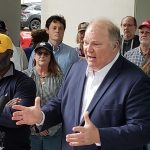Heartbeat City

Photos by Erin Landry
“If you were standing in this spot 150 years ago, you might have been run over by a train.”
On a cul-de-sac on the Hank Aaron State Trail – fish leaping in the Menomonee River below, the breeze carrying the scent of summer wildflowers – this interpretive sign is hard to swallow.
Before its industrialization, the Menomonee Valley was a natural wild rice marsh, an almost inconceivable place to build industry.
“It’s like building on oatmeal,” says Corey Zetts, Project Director for the Menomonee Valley Partners. The land was so swampy that the first rail tracks Byron Kilbourn laid sunk into the marsh overnight.
But engineering and ingenuity persevered, and Kilbourn’s Milwaukee & Waukesha Railroad spent years filling the valley with earth and timber to firm up the ground. By the Civil War, the Milwaukee Road had turned the city into an agricultural and industrial powerhouse. In 1895, the Falk Corporation was established in the Valley after Herman Falk’s failing family brewery, built in the Valley in 1856, burned down.
Together, Falk, the Milwaukee Road and the dozens of other breweries, stockyards, mills, packing plants and factories in the Menomonee Valley would become Milwaukee’s heart center for almost a hundred years, supplying thousands of jobs to a growing metropolis and bringing citizens from all sides of the city together in labor. But by the time sprawl and technology began to suck the wind out of the Valley’s sails after WWII, what was once a thriving channel of wilderness and wildlife was left polluted, smelly and blighted.
“The history is incredible,” says Melissa Cook, manager of the Hank Aaron State Trail, which cuts through the Valley like a vein. Her mother’s family lived on 39th and Michigan in Merrill Park; her relatives worked for Falk and the Milwaukee Road. The neighborhoods surrounding the Valley were built by investors in the railroad shops; today, they are some of the most diverse and densely populated districts in the state.
The Menomonee Valley – “borrowed” from its native residents and the natural order – provided the backbone for Milwaukee’s livelihood. Now, after more than 20 years of vision, planning and development, some of what was borrowed is being returned. What’s really amazing? It’s not at the expense of economic health or industry. In fact, the Valley’s health has been improving steadily for years.

Radical regrowth
Today’s Menomonee Valley is a testament to the power of synergy, synthesis and purposeful harmony.
Melissa likes to tell the story about the time she saw a man in a business suit walk to the river’s edge, pull on a pair of waders and go fishing on his lunch break.
“I asked him what he’d do if he caught any fish,” she says. “He said, ‘I’ve got a cooler in my trunk.’”
In 1999 – after several years of private-sector development and public-sector initiatives – the Menomonee Valley Partners, a non-profit corporation, was founded to bring together major Valley players, promote shared interests and facilitate sustainable redevelopment. It’s a time-tested formula for success: when everyone gets involved, everyone feels a sense of ownership, and things get done. Businesses are active in the planning and restoration of the Valley, and there’s proof of it everywhere: the state trail is bedded with crush from the Marquette Interchange; Sigma Environmental offers a public river trail on its property; there are even vestiges of the Valley’s past life, with picnic tables recycled from the old-growth oak that was used to build stockyard pens a century ago.
The Valley Partners embrace “sustainability in things big and little,” Corey says. The dedication to smart growth and adaptive re-use shows in everything from the park benches – half-buried concrete pipes – to the recycled, handcrafted stained glass panels that dot the railings, made by new Valley business Badger Railings, along the sidewalk.
Sixty acres of the Menomonee Valley’s west end make up a community park that serves as storm water treatment space, absorbing rainfall and preventing flooding and run-off pollution. The rest is set aside for industry, but the land is owned by the city; businesses moving into the Valley must pay their employees a living wage and comply with zoning laws that require an energy-efficient site layout, sustainable materials and construction and native landscaping.
Since the plan’s inception, 4,500 new jobs have been created and 12 new businesses have sited in the Valley, and the muscular collaboration mediated by the MVPs includes the Valley BID, the Business Association, representatives from the city, county and state, the MEDC, the Forest County Potawatomi Community, WE Energies and the Friends of the Hank Aaron State Trail.
The Valley provides a built-in value for its employees – immediate access to fishing, biking, hiking, scenic picnics on the river landing. Corey tells me about a P&H employee who lost 70 pounds after adopting a lunchtime speed-walking regimen. Employees of all sorts of Valley businesses – including Proven Direct, Sigma Environmental, Palermo’s Pizza and Cargill – organize stewardship crews, who have adopted segments of the trail.
Meanwhile, almost ten acres of the Menomonee Valley have reverted to their natural habitat. Birds have returned – kingfishers, great blue and green herons; turtles and deer are often spotted from the banks. The trail is seeded with dozens of native species – prairie clover and wild bergamot, spiderwort and hop sedge, red dogwood and goldenrod – many of them donated by Growing Power and planted by students from nearby schools, many of whom return to the Valley with their families to show off their work.

The Valley’s vein
From the steam arch at the 6th Street bascule bridge, the Hank Aaron State Trail runs along Canal Street to 25th, where it bends with the river and runs along its banks to Miller Park. The trail continues on surface streets to Lakeshore State Park on the east and connects to the Oak Leaf Trail on the west.
Dave Schlabowske, Milwaukee’s Bicycle and Pedestrian Task Force Coordinator, rides the trail from his home in Washington Heights to work almost every day – even though it’s a little out of his way.
“It makes the commute to work really enjoyable,” he says. “The entire way you’re smelling wildflowers, you can see salmon swimming – I don’t seem to tire of it, even though I take the same route all the time. Maybe because the seasons change, the flowers change – it’s a really pleasant way to get back and forth.”
Dave is a member of the Friends of the Hank Aaron State Trail, which holds its largest fundraiser on August 9 – the 5K run/walk that funds trail advocacy, safety, signage and special projects like a planned trail art initiative.
There’s already art on the trail, much of it installed to attract people to the secluded stretch that snakes along the water at 13th Street. A local school contributed student work and sidewalk paintings, and murals along the fence commemorate the 40th anniversary of Civil Rights March across 16th street. At a bend is a cornerstone with gears from an old bridge, lying in the grass like handsome sculptures.
“You can almost walk across the river on their backs,” says Schlabowske. The Menomonee River is one of the top urban fisheries in the world.
“I just got back from Montana, where people are out in crystal clear mountain streams fishing for trout,” he says. “I recognize the difference, but there’s something to be said for not having to go to Montana.”
And there’s something to be said for not having to leave Milwaukee. If you live or work near the center of the city, you can be on the trail in a half-hour or less. From there, you can kick off your shoes, walk down the flat slabs of salvaged rocks along the river’s banks, soak your ankles in the cool water and watch the birds. In the Rust Belt, where abandoned buildings, crumbling smokestacks and the legacy of industrial collapse – unemployment, broken infrastructure and a sense of despair – are part of the landscape, the Menomonee Valley is genius – an example of regeneration and new vitality on an almost epic scale. VS
For more information check out renewthevalley.org or hankaaronstatetrail.org




















